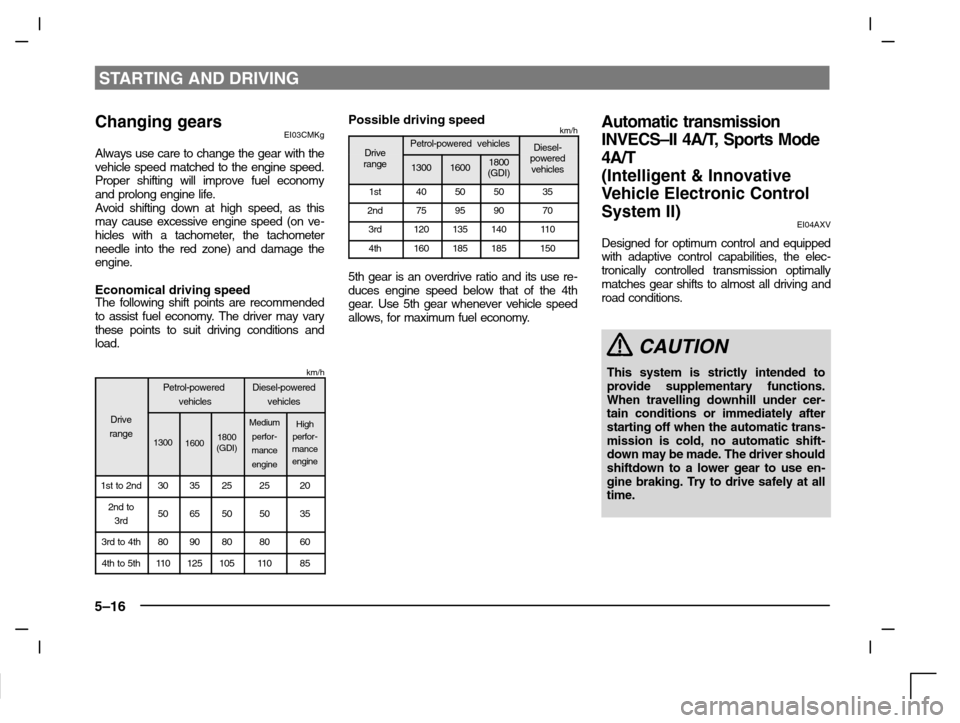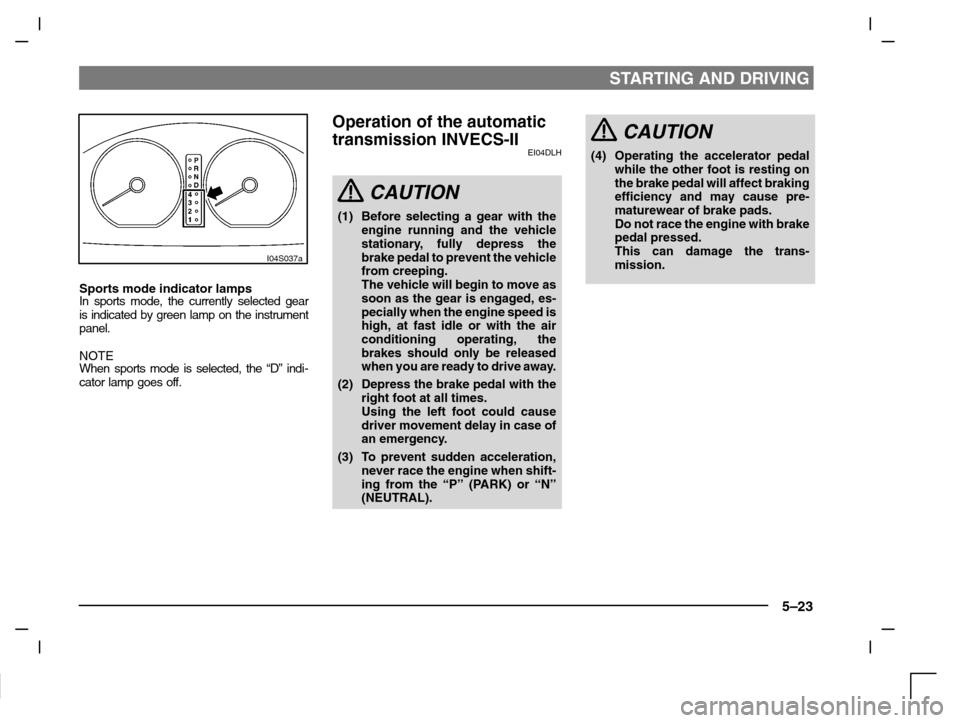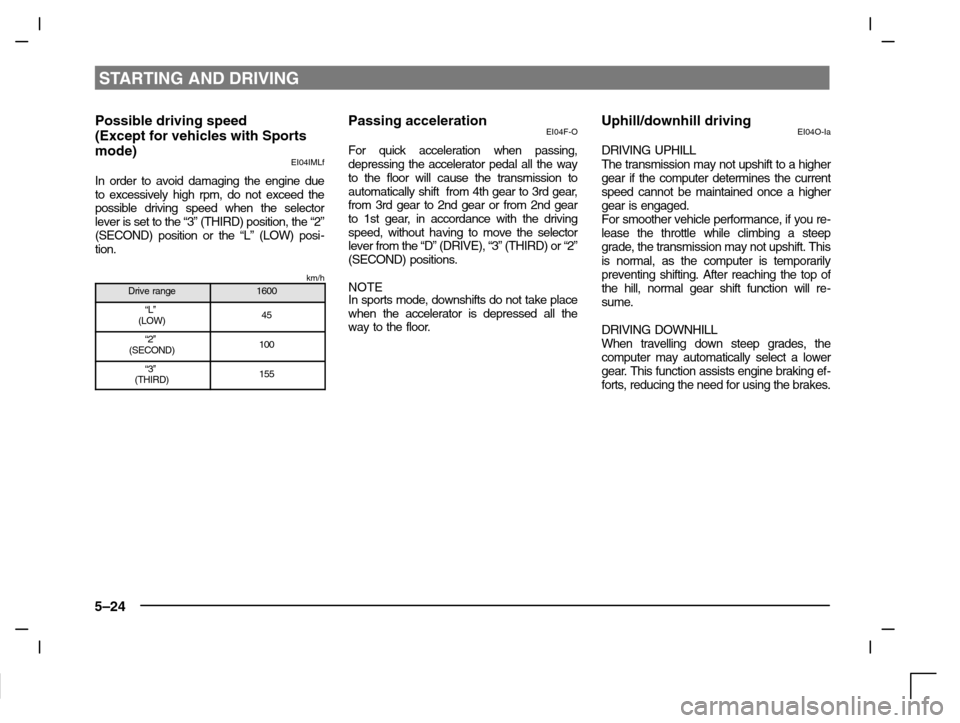2000 MITSUBISHI CARISMA automatic transmission
[x] Cancel search: automatic transmissionPage 112 of 280

STARTING AND DRIVING
5–12
StartingEI02FAIh
Tips for starting
(1) Do not operate the starter motor con-
tinuously for anything longer than 10
seconds; doing so could run down the
battery. If the engine does not start, turn
the ignition switch back to “LOCK”, wait
a few seconds, and then try again.
Trying repeatedly with the starter mo-
tor still turning will damage the starter
mechanism.
(2) If the engine cannot be started because
the battery is weak or dead, refer to the
“Emergency starting” section for instruc-
tions on starting the engine.
(3) The engine is well warmed up if the
coolant temperature gauge needle
starts to move (the engine speed de-
creases). Extended warming - up oper-
ation will result in excessive fuel con-
sumption.
WARNING
Never run the engine in a closed or
poorly ventilated area any longer than
is needed to move your vehicle in or
out of the area. Carbon monoxide
gases are odourless and can be fatal.
CAUTION
(1) Never attempt to start the engine
by pushing or pulling the vehicle.
Especially in the automatic trans-
mission since the structure is dif-
ferent from a manual transmis-
sion, it is not possible to start the
engine by using this technique.
Never attempt this or it could
damage the automatic transmis-
sion.
(2) Do not run the engine at high rpm
or drive the vehicle at high speed
until the engine has a chance to
warm up.
(3) Release the ignition key as soon
as the engine starts to avoid dam-
aging the starter motor.
(4) If your vehicle is equipped with a
turbocharger, do not stop the en-
gine immediately after operating
the vehicle at high speeds. Allow
the engine to idle for approxi-
mately 60 seconds or more to
give the turbocharger a chance to
cool down.
NOTE
After replacing the battery, the electronic
control system data for the engine, auto-
matic transmission, etc., will be erased. As a
result, the engine speed may become un-
stable and shift shocks may occur.
If the engine speed becomes unstable, initial
engine adjustments will need to be per-
formed.
Refer to the section ”What to do if the engine
speed becomes unstable after the battery is
replaced” on page 8–22.
Shift shocks will become smoother after sev-
eral changes in speed.
Page 113 of 280

STARTING AND DRIVING
5–13
I27A036a
Starting the engine
(Petrol-powered vehicles)
This vehicle is equipped with an electroni-
cally controlled fuel injection system which
is automatically controlled. When starting
the engine, do not depress the accelerator
pedal.
Normal conditions
The starting procedure is as follows :
1. Insert the ignition key and fasten the
seat belt.
2. Apply the parking brake.
3. Depress and hold the brake pedal.
4. Place the gearshift lever (manual
transmission) in the “N” (Neutral) or
the selector lever (automatic trans-
mission) in the “P” (PARK) position.
5. Fully depress the clutch pedal (man-
ual transmission).
6. After turning the ignition key to the
“ON” position, make certain that all
warning lamps are functioning proper-
ly before starting the engine.
7. Turn the ignition key to the “START”
position without depressing the accel-
erator pedal, and release it when the
engine starts.
NOTE
A ticking noise may be heard after starting
the engine. This is not an abnormal condi-
tion. The noise will disappear after a short
time of engine running.
If the ticking noise continues after the engine
is warmed up, have your vehicle checked at
an authorized MITSUBISHI dealer.
Flooded engine
If the engine has become flooded during
starting, first operate the starter for 5 to 6 sec-
onds while fully depressing the accelerator
pedal, then start the engine without depres-
sing the accelerator pedal.
At extreme cold ambient
temperature
If the engine won’t start, depress the accel-
erator pedal about halfway while cranking
the engine. Once the engine starts, re-
lease the accelerator pedal.
CAUTION
When starting the engine, make sure
that you press on the brake pedal. At
extreme cold ambient temperature,
move your foot to the brake pedal im-
mediately after the engine has
started.
Page 116 of 280

STARTING AND DRIVING
5–16
Changing gearsEI03CMKg
Always use care to change the gear with the
vehicle speed matched to the engine speed.
Proper shifting will improve fuel economy
and prolong engine life.
Avoid shifting down at high speed, as this
may cause excessive engine speed (on ve-
hicles with a tachometer, the tachometer
needle into the red zone) and damage the
engine.
Economical driving speedThe following shift points are recommended
to assist fuel economy. The driver may vary
these points to suit driving conditions and
load.
km/h
Petrol-powered
vehiclesDiesel-powered
vehicles
Drive
range
130016001800
(GDI)
Medium
perfor-
mance
engineHigh
perfor-
mance
engine
1st to 2nd3035252520
2nd to
3rd5065505035
3rd to 4th8090808060
4th to 5th11 012510511 085
Possible driving speedkm/h
DrivePetrol-powered vehiclesDiesel-Driverange130016001800
(GDI)powered
vehicles
1st40505035
2nd75959070
3rd12013514011 0
4th160185185150
5th gear is an overdrive ratio and its use re-
duces engine speed below that of the 4th
gear. Use 5th gear whenever vehicle speed
allows, for maximum fuel economy.
Automatic transmission
INVECS–II 4A/T, Sports Mode
4A/T
(Intelligent & Innovative
Vehicle Electronic Control
System II)
EI04AXV
Designed for optimum control and equipped
with adaptive control capabilities, the elec-
tronically controlled transmission optimally
matches gear shifts to almost all driving and
road conditions.
CAUTION
This system is strictly intended to
provide supplementary functions.
When travelling downhill under cer-
tain conditions or immediately after
starting off when the automatic trans-
mission is cold, no automatic shift-
down may be made. The driver should
shiftdown to a lower gear to use en-
gine braking. Try to drive safely at all
time.
Page 119 of 280

STARTING AND DRIVING
5–19
Except for vehicles with Sports mode
I04A229a
Indicator lamps
A- Selector lever position indicator lamp
B- “N” indicator lamp
The indication lamps in the instrument panel
are for indication the selector lever position
and one of them will be illuminated when the
ignition is switched “ON”.
I04A257a
Vehicles with Sports mode
CAUTION
If the “N” (NEUTRAL) indicator lamp
in the selector lever position indicator
flashes while you are driving, there
could be a malfunction in the auto-
matic transmission. (If the selected
lever position is in the “P” (PARK),
“R” (REVERSE) or “N” (NEUTRAL)
position, the indicator lamp does not
flash.) Identify and rectify the problem
in accordance with the following pro-
cedure.
CAUTION
[The “N” indicator lamp flashes rapid-
ly (twice per second)]
The automatic transmission fluid is
overheating.
Park your vehicle in a safe place but
do not turn off the engine. Move the
selector lever to the “P” (PARK) posi-
tion and open the bonnet. Keep the
engine idling.
After a while, move the selector to the
“D” position and confirm that the “N”
indicator lamp stops flashing. It is safe
to continue driving if the “N” indicator
lamp no longer flashes.
Be sure to carry out this check with
the selector lever in the all forward
position except for “P” (PARK), “R”
(REVERSE) or “N” (NEUTRAL). The
“N” indicator lamp warning function
operates only in these positions.
If the “N” indicator lamp continues
flashing or flashes intermittently,
have your vehicle inspected by an
authorized MITSUBISHI dealer.
Page 120 of 280
![MITSUBISHI CARISMA 2000 1.G Owners Manual STARTING AND DRIVING
5–20
CAUTION
[The “N” indicator lamp flashes slow-
ly (once per second)]
The automatic transmission safety
device may be operating due to a mal-
function.
Have your vehicle MITSUBISHI CARISMA 2000 1.G Owners Manual STARTING AND DRIVING
5–20
CAUTION
[The “N” indicator lamp flashes slow-
ly (once per second)]
The automatic transmission safety
device may be operating due to a mal-
function.
Have your vehicle](/manual-img/19/7563/w960_7563-119.png)
STARTING AND DRIVING
5–20
CAUTION
[The “N” indicator lamp flashes slow-
ly (once per second)]
The automatic transmission safety
device may be operating due to a mal-
function.
Have your vehicle inspected by an
authorized MITSUBISHI dealer as
soon as possible.
Selector positionsEI04BALb
P - PARKThis position locks the transmission to pre-
vent the vehicle from moving. The engine
can be started in this position.
R - REVERSEMove the lever to this position only after the
vehicle has come to a complete stop.
CAUTION
Never shift into the “P” (PARK) or “R”
(REVERSE) position while the vehicle
is in motion. If the lever is shifted into
the “P” or “R” position while the ve-
hicle is in motion, the transmission
may be damaged.
N - NEUTRALAt this position, the transmission is disen-
gaged. It is the same as the neutral position
on a manual transmission, and should be
used when the vehicle is stationary for an ex-
tended length of time during driving, such as
in a traffic jam.
WARNING
(1) Never move the selector lever to
the “N” position while driving.
A serious accident could occur
since you could accidentally
move the lever into the “P” or “R”
position and engine braking
would be lost.
(2) On a slope gradient, the engine
should be started in the “P”
(PARK) position, not in the “N”
(NEUTRAL) position.
(3) Always keep your right foot on
the brake pedal when the vehicle
is in “N” (NEUTRAL), or when
shifting into or out of “N” (NEU-
TRAL), to minimize the risk of
loss of control.
D - DRIVEThis position is for normal driving.
The transmission automatically selects a
suitable gear for your speed and acceler-
ation.
Engine braking is automatically applied
when necessary, depending on road condi-
tions.
Please refer to “Uphill/downhill driving” on
page 5–24.
Page 122 of 280

STARTING AND DRIVING
5–22
I04S040a
Sports mode
(Vehicles with Sports mode)
EI04S-Oa
Whether the vehicle is stationary or in mo-
tion, sports mode is selected by pushing the
selector lever from the “D” (DRIVE) position
into the manual gate (A). To return to “D”
range operation, push the selector lever
back into the main gate (B).
In sports mode, gear shifts can be made
rapidly simply by moving the selector lever
backwards and forwards. In contrast to a
manual transmission, the sports mode al-
lows gear shifts with the accelerator pedal
depressed.
+ (UP): Push the lever forward once to shift
up one gear.
– (DOWN): Pull the lever backwards once to
shift down one gear.
CAUTION
(1) Upward shifts do not take place
automatically in sports mode.
The driver must execute upward
shifts in accordance with prevail-
ing road conditions, taking care
to keep the engine speed below
the red zone.
(2) By rapidly moving the selector
lever backwards (DOWN) twice, it
is possible to skip one gear, i.e.,
3rd to 1st or 4th to 2nd. Since
sudden engine braking and/or
rapid accelera-tion can cause a
loss of traction, however, down-
shifts must be made carefully in
accordance with the vehicle’s
speed.
NOTE
(1) In sports mode, only the 4 forward gears
can be selected. To reverse or park the
vehicle, move the selector lever to the
“R” (REVERSE) or “P” (PARK) position
as required.
(2) To maintain the required levels of ve-
hicle performance and safety, the sys-
tem may not execute certain gear shifts
when the selector lever is operated,
such as 4th gear at low speed.
(3) In sports mode, downward shifts are
made automatically when the vehicle
slows down. When the vehicle stops,
1st gear is automatically selected.
(4) When driving away on a slippery road,
push the selector lever forward into the
+(UP) position. This causes the trans-
mission to shift into the 2nd gear which
is better for smooth driving away on a
slippery road. Push the selector lever to
the – (DOWN) side to shift back to the
1st gear.
(5) Move the selector lever gently between
the manual and main gates and be-
tween positions in the manual gate.
Undue force could damage the selector
lever.
Page 123 of 280

STARTING AND DRIVING
5–23
I04S037a
Sports mode indicator lampsIn sports mode, the currently selected gear
is indicated by green lamp on the instrument
panel.
NOTE
When sports mode is selected, the “D” indi-
cator lamp goes off.
Operation of the automatic
transmission INVECS-II
EI04DLH
CAUTION
(1) Before selecting a gear with the
engine running and the vehicle
stationary, fully depress the
brake pedal to prevent the vehicle
from creeping.
The vehicle will begin to move as
soon as the gear is engaged, es-
pecially when the engine speed is
high, at fast idle or with the air
conditioning operating, the
brakes should only be released
when you are ready to drive away.
(2) Depress the brake pedal with the
right foot at all times.
Using the left foot could cause
driver movement delay in case of
an emergency.
(3) To prevent sudden acceleration,
never race the engine when shift-
ing from the “P” (PARK) or “N”
(NEUTRAL).
CAUTION
(4) Operating the accelerator pedal
while the other foot is resting on
the brake pedal will affect braking
efficiency and may cause pre-
maturewear of brake pads.
Do not race the engine with brake
pedal pressed.
This can damage the trans-
mission.
Page 124 of 280

STARTING AND DRIVING
5–24
Possible driving speed
(Except for vehicles with Sports
mode)
EI04IMLf
In order to avoid damaging the engine due
to excessively high rpm, do not exceed the
possible driving speed when the selector
lever is set to the “3” (THIRD) position, the “2”
(SECOND) position or the “L” (LOW) posi-
tion.
km/hDrive range1600
“L”
(LOW)45
“2”
(SECOND)100
“3”
(THIRD)155
Passing accelerationEI04F-O
For quick acceleration when passing,
depressing the accelerator pedal all the way
to the floor will cause the transmission to
automatically shift from 4th gear to 3rd gear,
from 3rd gear to 2nd gear or from 2nd gear
to 1st gear, in accordance with the driving
speed, without having to move the selector
lever from the “D” (DRIVE), “3” (THIRD) or “2”
(SECOND) positions.
NOTE
In sports mode, downshifts do not take place
when the accelerator is depressed all the
way to the floor.
Uphill/downhill drivingEI04O-Ia
DRIVING UPHILL
The transmission may not upshift to a higher
gear if the computer determines the current
speed cannot be maintained once a higher
gear is engaged.
For smoother vehicle performance, if you re-
lease the throttle while climbing a steep
grade, the transmission may not upshift. This
is normal, as the computer is temporarily
preventing shifting. After reaching the top of
the hill, normal gear shift function will re-
sume.
DRIVING DOWNHILL
When travelling down steep grades, the
computer may automatically select a lower
gear. This function assists engine braking ef-
forts, reducing the need for using the brakes.